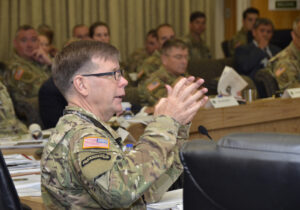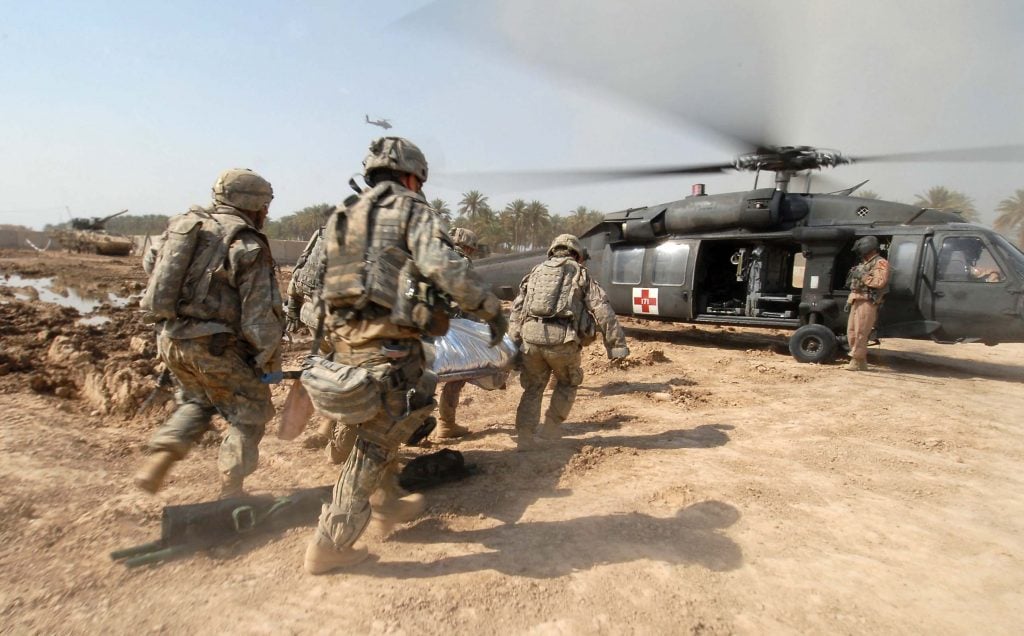By SYDNEY J. FREEDBERG JR.
Soldiers rush a wounded civilian to a UH-60 medevac helicopter in Iraq.
AUSA: In war zones like Afghanistan, medevac pilots know that if they can get wounded soldiers to the hospital in 60 minutes – the “golden hour” – their chances of survival go way up. But in the battle between truth and propaganda on the global internet, “it’s not the golden hour,” said Lt. Gen. Stephen Fogarty, chief of Army Cyber Command. “It’s probably that golden five minutes, or that golden 20 to 30 minutes, to recognize what adversary is putting out there [and] respond.”
Lt. Gen. Stephen Fogarty, chief of Army Cyber Command, addresses fellow senior officers.
 What that response should be will vary, Fogarty and other experts say. It could be as simple as an Army public affairs officer seeing a false tweet – a claim a US airstrike hit a hospital, for instance – and immediately posting a rebuttal. It could be as old-school as jamming broadcasts by a pirate radio station. Or, as in the campaign against the Islamic State, it could involve sophisticated pattern analysis and cyber forensics to identify social media accounts being used by terror groups, then contacting Twitter and Facebook to get them banned, or contacting the local police to get them arrested, or hacking their computers, or even (in a war zone) sending Special Operations Forces or a smart bomb to their real-world location.
What that response should be will vary, Fogarty and other experts say. It could be as simple as an Army public affairs officer seeing a false tweet – a claim a US airstrike hit a hospital, for instance – and immediately posting a rebuttal. It could be as old-school as jamming broadcasts by a pirate radio station. Or, as in the campaign against the Islamic State, it could involve sophisticated pattern analysis and cyber forensics to identify social media accounts being used by terror groups, then contacting Twitter and Facebook to get them banned, or contacting the local police to get them arrested, or hacking their computers, or even (in a war zone) sending Special Operations Forces or a smart bomb to their real-world location.
Whatever the response, however, it needs to happen fast, Fogarty argued. Otherwise, your situation brings to mind the old maxim – often misattributed to Mark Twain – that a lie can circle the globe while the truth is still putting its boots on.
Now, despite its bureaucratic reputation, the US military is very good at doing some things very fast, like providing air and artillery support to an infantry patrol caught in an ambush, or sending medical evacuation helicopters to pick up the wounded. But official announcements and rebuttals often go through hours, days, or weeks of review before all the officers and officials involved approve the final version for release. “In many cases,” Fogarty’s deputy complained in September, “it’s easier to drop a bomb on somebody than to send them a leaflet or an email.”
To speed up this process, Fogarty said here, it’s not necessary to give Army Cyber Command – soon to be renamed Information Warfare Command – new legal authorities. What’s necessary is to delegate them down to officers on the digital front line.
The Army seeks a next-generation armed scout helicopter with increased speed, range, survivability and even autonomy – not just a conventional helicopter.
“We’ve got to push authorities down to the lowest level practical,” Fogarty said here. “Some people are concerned about that, it may misfire, it may not get it exactly.” But it’s an old military adage that taking too long to devise the perfect plan is far more dangerous than doing something not-quite-right at the right time.
“The risk calculus generally runs, ‘hey,’ if we do this, we could make a mistake, this could be a problem,’” he told me after his formal press conference here. “Our comeback is, we need to flip that discussion — if we don’t compete, we cede the environment to the adversary… They’re going to steal the narrative.”
Ryan McCarthy visits soldiers in the United Arab Emirates.
“We are actually engaged in information operations today,” Fogarty said at the press conference. “Whether we want it or not, that’s the environment we actually operate in today. I would argue I’ve been engaged in information warfare since the day I took this job. We didn’t call it that.”
That’s why Fogarty has recommended, and Army leaders have tentatively approved, reorganizing Army Cyber Command into an Information Warfare Command. Many details are still being discussed, including the exact name, Fogarty cautioned. But with both Army Secretary Ryan McCarthy and Chief of Staff Gen. James McConville endorsing the concept at AUSA, the change is all but certain to happen.
“We’re looking very hard at that proposal, it makes a lot of sense,” McCarthy said at his press conference. “if you see the way the other services are organized in particular, [it’s] similar to what he’s [Fogarty has] proposed.” That said, the plan must be reviewed with “rigor and due diligence” because it will change the command’s legal authorities.
“We’re re-organizing Army Cyber Command to synchronize Army information warfare capabilities,” McConville declared in his speech to AUSA. “Its new alignment will change how we conduct Information Warfare by integrating and employing Intelligence, Information Operations, Cyber, Electronic Warfare and Space capabilities to provide Combatant Commanders with options to compete below the level of armed conflict” — the Cold War-like mix of hacking, propaganda, and proxy forces many experts call the grey zone.
Now, the new name doesn’t come with a lot of new resources. “We’re not predicting any huge growth,” Fogarty told me. “What we’re trying to do is organize so we can compete much more effectively and much faster.”
“Right now, I’m responsible for the cyber domain. That’s where my little box is: It’s EW [electronic warfare], it’s IO [information operations], and cyber,” Fogarty continued. But information warfare writ large touches on other branches from intelligence to space, from psychological operations to public affairs, all of which have input into the reorganization.
“I don’t have to own all that stuff,” Fogarty said. “I’m not going to own it all, but what we need to do is, we’ve got to integrate more effectively.”

No comments:
Post a Comment